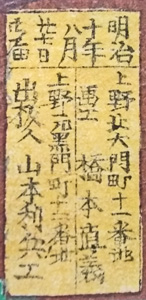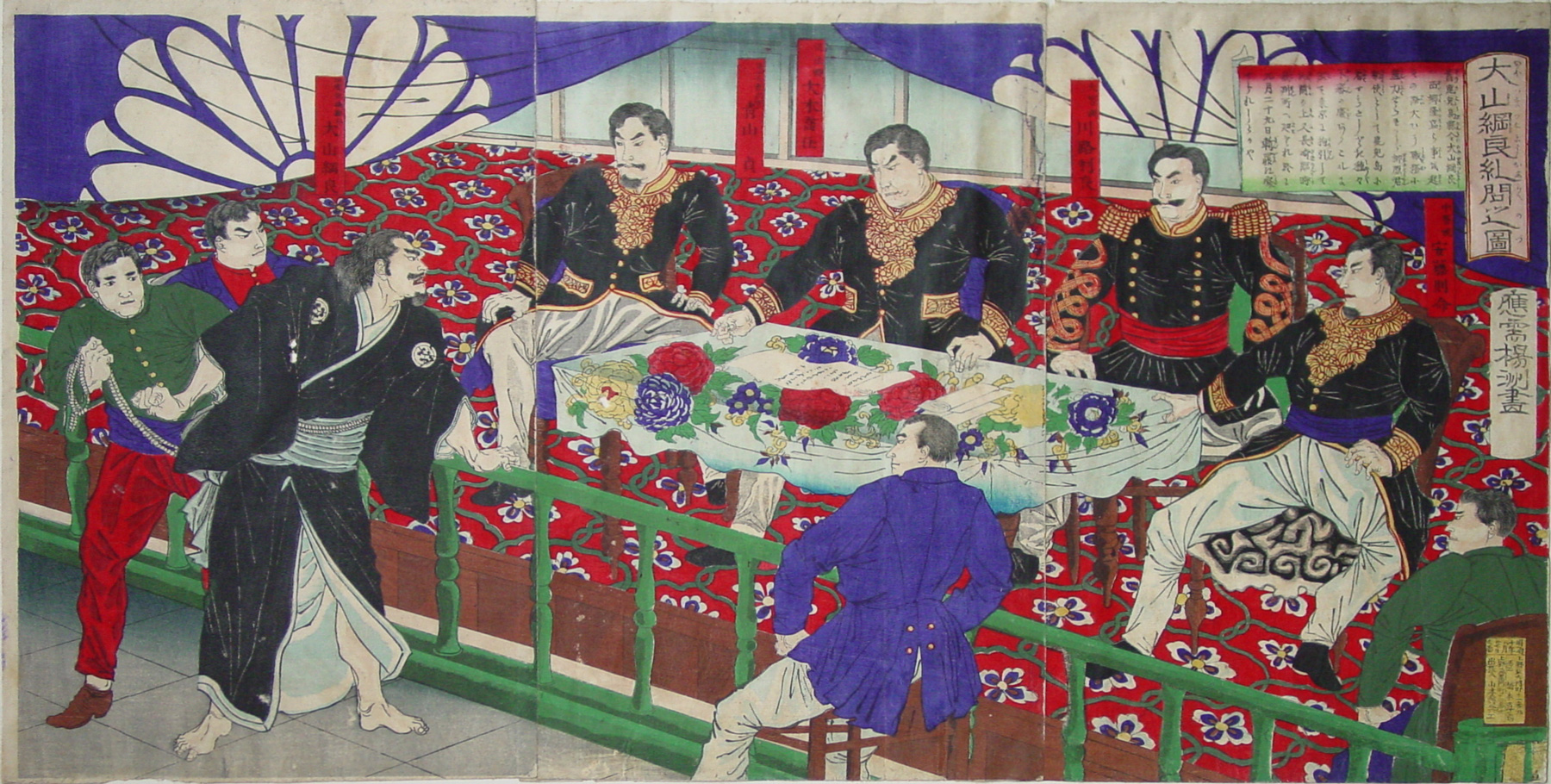About This Print
Ōyama Tsunayoshi 大山綱良, vice-governor of Kagoshima at the outbreak of the Satsuma Rebellion (a.k.a. West-South or Seinan War) in February 1877 and close friend of the rebel leader Saigo Takamori, faces a tribunal having been accused of treason.
The left-most figure on the right panel is National Police Chief Kawaji Toshiyoshi 川路利良 (1834-1879) who was responsible for sending Satsuma natives to their home province with orders to infiltrate the Shigakko (military academies for samurai which Saigo Takamori led) and dissuade them from anti-government action. He also appears in the print Report on the Actual Condition at the Battlefield.
Oyama Tsunayoshi and the Satsuma Rebellion (Three Accounts)
Three accounts of Governor Oyama's fate follow. The first, an 1879 account by Augustus Henry Mounsey (Great Britain's Japan Legation Secretary, 1876-?) states that Oyama was executed. The second, an 1881 account by John R. Black (newspaper editor)1, states that Oyama was made a "close prisoner." The third, from a recently published work by Mark Ravina (Director of the East Asian Studies Department, Emory University), states that Oyama was sent to "Osaka for the duration of the war." Black states that the charges against Oyama "were never distinctly defined" while Mounsey provides the text of the charges and the sentence handed out. References to 1877 as the date of Oyama's death2 support Mounsey's account.
Augustus Henry Mounsey's Account Governor Oyama's Arrest
Source: The Satsuma rebellion: An Episode of Modern Japanese History, Augustus Henry Mounsey, John Murray, London, 1879, p. 227-229.
Prior to the commencement of hostilities against the Imperial government by the Satsuma forces, Emperor Meiji dispatched special envoy Yanagiwara Chikamitsu to Kagoshima for the purpose of conferring with the leaders of the insurrectionary movement. Yanagiwara had deep, and well-founded suspicions about the loyalty of Kagoshima's governor, Oyama Tsunayoshi, who had been appointed through the efforts of rebel leader Saigo Takamori. "[U]nder promises of safe conduct... [t]he envoy and the governor left Kagoshima [for Kyoto] March 14th, when the preliminary struggles between the opposing forces were being enacted in indecisive skirmishes. On the arrival of Yanagiwara at Kioto, Oyama was instantly made a prisoner; he was subsequently degraded, and sent, with every mark of indignity, to Tokio for trial."
Oyama was convicted and his sentence read:
| Oyama Tsunayoshi, a Samurai of the Kagoshima prefecture. During the time you acted as governor of the Kagoshima prefecture, you, in violation of the laws of the empire, assisted Saigo Takamori and others in their treason. You received the confessions of police sergeant Nakahara Hisao and others, which were merely concocted by the 'private school'3 party, you had them printed and you circulated throughout the Kagoshima prefecture, a notification to the effect that a plot to assassinate Saigo and others had been discovered, and that Saigo was in consequence about to proceed to Tokio at the head of his troops. In order to excite the sympathy of the people of the country, you dispatched emissaries to other prefectures and cities. You further employed the officials of your prefecture in the service of the rebels and handed over 150,000 yen (£30,000) belonging to the government to Saigo. Furthermore, you established a commissariat department within the grounds of the government house, in order to furnish the rebels with supplies. For these crimes you are deprived of the rank of Shizoku and sentenced to undergo decapitation." |
John R. Black's Account Governor Oyama's Arrest
Source: Young Japan. Yokohama and Yedo. A Narrative of The Settlement of the City from the Signing of the Treaties in 1858, to the Close of the Year 1879, John R. Black, Trubner & Co., 1881, Vol. II, p. 484.
"Prior to the commencement of hostilities Yanagiwara had been dispatched by the Mikado as special envoy to Kagoshima for the purpose of conferring with the leaders of the insurrectionary movement; and it is believed that abundant proof was furnished to him that the Bhimadzu family were not implicated. Suspicions were aroused in the mind of Yanagiwara respecting the loyalty of Oyama Tsunayoshi, governor of Kagoshima, who was prevailed on, under promises of safe conduct, to accompany Yanagiwara on his return to Kioto. The envoy and the governor left Kagoshima March 14th, when the preliminary struggles between the opposing forces were being enacted in indecisive skirmishes. On the arrival of Yanagiwara at Kioto, Oyama was instantly made a prisoner; he was subsequently degraded, and sent, with every mark of indignity, to Tokio for trial."
"On the 22nd March, Oyama Tsunayoshi was deprived of his rank and office, and held a close prisoner upon charges never distinctly defined."
Mark Ravina's Account of Governor Oyama's Arrest
Source: The Last Samurai: The Life and Battles of Saigo Takamori, Mark Ravina, John Wiley & Sons, Inc., 2004, p. 207.
"On March 9 the government landed forces in Kagoshima and seized control of all the war material there, including more than four thousand barrels of gunpowder. They took Governor Oyama into custody and sent him to Osaka for the duration of the war."
1 The title page of Black's work provides a brief CV of the author, as follows: "Formerly Editor of the 'Japan Gazette,' and of the 'Japan Herald'; Editor of the 'Far-East,' Illustrated Monthly Magazine. Also the Proprietor and Editor of the 'Nisshin Shinjishi'—the first Newspaper, (worthy of the nameJ, ever published in the native language in Japan."
2 The Waseda University database entry for a letter written by Oyama lists 1825-1877 as his birth-death years.
3 'Private school' is a reference to a series of military academies set up by Saigo Takamori in 1873 in Kagoshima for the support and training of unemployed samurai.
Print Details
| IHL Catalog | #445 |
| Title or Description | The Arraignment of Ōyama Tsunayoshi Ōyama Tsunayoshi kyūmon no zu (as given by The Metropolitan Museum of Art) Ōyama Tsunayoshi oshirabe no zu (as given by the Museum of Fine Arts, Boston) 大山綱良糺問之図 |
| Series | |
| Artist | Yōshū Chikanobu (1838-1912) |
| Signature |  應需 楊洲 畫 Ōju Yōshū ga (drawn by special request, Yōshū) |
| Seal | no artist seal |
| Publication Date | August 27, 1877 明治十年八月廿七日 [see publisher's seal below] |
| Publisher |  Yamamoto Rihei 山本利兵エ - family name of the publisher Iseya Rihei 伊勢屋利兵衛 Yamamoto Rihei 山本利兵エ - family name of the publisher Iseya Rihei 伊勢屋利兵衛[Marks: pub. ref. 152] 画工 橋本直義 artist Hashimoto Naoyoshi (artists real name) 出版人 山本利兵エ publisher Yamamoto Rihei |
| Impression | excellent |
| Colors | excellent |
| Condition | good – three panels joined; remnants of prior mounting along top margin; light soiling throughout; minor damage along bottom margin; full-size untrimmed sheets. |
| Genre | ukiyo-e; senso-e |
| Miscellaneous | |
| Format | vertical oban triptych |
| H x W Paper | 14 1/2 x 28 3/4 in. (36.82 x 73 cm) |
| Literature | |
| Collections This Print | Museum of Fine Arts, Boston 2000.198a-c; The Metropolitan Museum of Art JP3236 |
12/15/2020
1/6/2019


